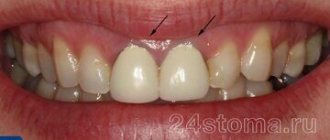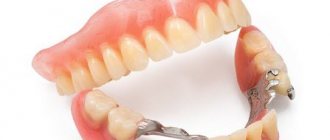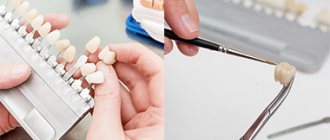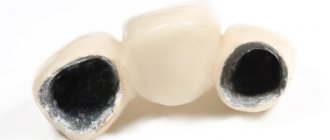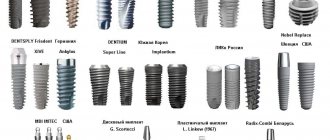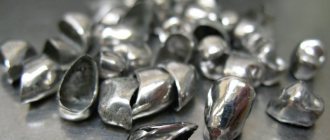Metal-plastic crowns
Such prostheses are called conditionally temporary crowns. A cost-effective prosthetics option that involves installing crowns with a metal base and a plastic coating. Traditionally, structures are made of nickel, cobalt, and chromium.
Despite the natural appearance and relatively good functionality, it is not worth wearing such prostheses for a long time: the product quickly loses its whiteness, slightly increases in size and needs to be replaced.
Among the undeniable advantages of metal plastic are its low cost and gentle effect on the enamel layer of the tooth. If the product is slightly deformed, it can be repaired directly in the patient’s mouth. Among the disadvantages of this choice, it is worth highlighting the low strength of the structure and the likelihood of developing allergies.
Metal-ceramic crowns
Practice shows that metal-ceramic crowns are deservedly considered the most popular. The base of the product is metal (cobalt, chromium, titanium, gold, etc.). To give the crown an aesthetic appearance, the metal base is covered with a ceramic layer and the elements are connected by exposure to high temperatures.
The popularity of metal ceramics in prosthetics is explained by its obvious advantages:
- Aesthetics. The material with which the crown frame is covered completely recreates the anatomical structure of the enamel;
- Sufficient strength. The products are quite durable due to the cast metal frame - they can withstand normal chewing loads and do not wear out. It is rare to see chipping of the enamel coating. In this case, repair of the prosthesis can be done in the patient’s mouth;
- Versatility. Crowns of this type are installed both on individual fragments of a row, and in the form of a dental bridge.
Since the ceramic layer is completely opaque, the prosthetic fragment (especially with a single restoration) can stand out against the background of natural teeth. Another disadvantage of metal-ceramic crowns is the need to grind the unit, after which it forever loses its original shape.
Metal crowns
These are the predecessors of all other types of dentures. This type of prosthesis is indicated for installation only on chewing teeth, since the structures are noticeable on the front teeth. Metal crowns are made of steel, titanium, platinum, and gold. Alloys containing cobalt, chromium, and silver are also in demand.
In laboratory conditions, stamped or cast products with spraying are prepared for patients. Standard structures take on the desired shape as work progresses. Individual production of the cap guarantees maximum adherence to the tissues, which eliminates rapid abrasion of the material and the spread of bacteria under the prosthesis.
Among the advantages of such products, it is worth noting their exceptional strength (due to the plasticity of the material, a crown made of this type of material does not crack and does not wear out for a long time). However, metal dentures are extremely unaesthetic, can cause allergies, and are difficult to fit on a tooth.
In addition, when using metal prosthetics, it is worth considering that crowns made from several types of metal cannot be used at once. If the patient already has a steel structure in his mouth, in the future he will have to fix crowns only from this material. Otherwise, the patient may develop galvanic syndrome, which is manifested by a burning sensation in the mouth and a “metallic” taste.
Metal-free ceramics on teeth - pros and cons
Ask a Question
Metal-free ceramics are very popular in dentistry; crowns are made from this material, mainly for anterior (front) teeth. As the name implies, this material does not contain metals or their alloys; it visually replicates the shape and color of real teeth, which is selected according to the Witt scale. Due to this identity with metal-free ceramics, they are used primarily for prosthetics in the smile area.
Metal-free ceramics have pros and cons - before choosing it, you should carefully study all the advantages and disadvantages. Let's talk in more detail about the characteristics of this material.
Advantages of metal-free ceramics
Metal-free crowns are the choice of many patients. This material is practical and aesthetic, and is used for prosthetics, when the first thing you need to do is restore a beautiful smile.
Let us list the main advantages of the material:
- beautiful appearance - completely imitates teeth, indistinguishable from them even in the light;
- the color remains unchanged throughout operation, even upon contact with coloring substances (tea, coffee);
- metal-free crowns are thin, which reduces the load on the tooth; during prosthetics, less hard tissue is worn down and the gums are not injured;
- when installing crowns, the tooth is not depulped, and teeth with living vessels and nerves are much more durable;
- ceramics is a hypoallergenic material that does not cause irritation upon contact with mucous membranes.
Another plus is that if you have a metal-free crown, there is no risk of a metal border appearing due to receding gums, as with a metal-ceramic crown.
Disadvantages of metal-free ceramics
Despite the popularity of metal-free ceramics, this material has disadvantages that need to be considered before choosing:
- such crowns cannot withstand high chewing loads, so they are installed in the smile area, where beauty is more important than practicality;
- since crowns are quite thin, so their use to hide extensive defects in the front teeth is impractical - the color of the filling material can show through and be noticeable in the light;
- cost – the price of a metal-free crown is high, starting from 18 thousand rubles.
Ceramics or metal ceramics?
The difference between the materials is that to make metal-ceramics, the ceramics are fused or sprayed onto a prepared alloy frame. Metal-free crowns do not have such a base; they are made from pure ceramics. Due to such features, they have different properties, and the cost of materials also differs.
| Peculiarity | Metal-free crowns | Metal ceramics |
| Aesthetic properties of materials | They completely replicate the shape of teeth and the color of enamel even in the light. Because of these features, crowns are chosen for the smile area. If the defect is large, the color of the filling may show through the thin frame of the crown. When the gums recede, a metal band does not appear | Ceramic coating is similar in color and shape to adjacent teeth, but may be noticeable in the smile area. When the gums recede, a metal band is visible. |
| Strength | More fragile, may break under high chewing loads | Durable, withstands the loads that the masticatory muscles develop. |
| Features of prosthetics | Crowns are thin and do not require much grinding of the tooth to install them. The risks of depulpation are minimal. | To install crowns, you have to grind down the tooth heavily, which reduces its strength. Dental depulpation is often performed with the removal of blood vessels and nerves. |
| Average service life | 5-7 years | 8-12 years |
| Average cost of a crown | 18-21 thousand rubles | 10-13 thousand rubles. |
From the review it is clear that metal-free ceramics are superior in aesthetics, but inferior to metal ceramics in strength and durability. Such crowns are more expensive, they are chosen mainly for the anterior sections, where beauty is more important than practicality. If there is a risk of depulpation during prosthetics, choose metal-free ceramics.
Ceramic or zirconia crowns?
Zirconium dioxide crowns are made from a high-strength white alloy onto which ceramic is sprayed or fused. The table shows a comparison of such crowns with metal-free ones.
| Peculiarity | Metal-free crowns | Zirconium dioxide crowns |
| Appearance | Completely imitate the color and shape of teeth | Also look beautiful, indistinguishable from real teeth |
| Strength | Fragile, installed in the anterior sections | Durable, suitable for prosthetics of anterior or posterior teeth |
| Irritation of the mucous membrane | Do not cause allergies | Do not cause allergies |
| Average service life | 5-7 years | 15 years |
| Price | 18-21 thousand rubles | 28-32 thousand rubles. |
Crowns made of zirconium dioxide are superior in almost all respects, but they are significantly more expensive. Before prosthetics, it is important to contact an experienced dentist who can advise which option to choose – metal-free or zirconium crowns. If the chewing loads in the prosthetic area are low and the material does not cause allergies, you can install a metal-free crown and save money.
ActiveDent dental specialists are interested in the correct selection of crowns, dentures and bridges for patients - we cooperate with the best dental laboratories, which guarantees quality treatment for each patient. We install crowns from compatible materials that are indistinguishable from real teeth. Sign up for a consultation with us, the dentist will conduct an examination, recommend crowns that are right for you and give you an estimate on the cost of prosthetics.
Ceramic crowns for teeth
Metal-free crowns are deservedly recognized as the most aesthetic: they are extremely difficult to distinguish from natural teeth, even if the gum tissue becomes thinner, the prosthesis remains invisible and looks natural. In dentistry, several types of metal-free dental crowns are used:
- Porcelain or all-ceramic. They are made according to a personal impression from pressed material without adding other components.
- Mixed (zirconium dioxide and ceramics). They are stronger than the previous type of prosthesis, have high light transmittance and do not cause allergies.
- Mixed (aluminum oxide and ceramics). The designs are made of translucent hypoallergenic material, which is comfortable to wear and resistant to temperature changes.
All ceramic products are biologically compatible with mucous membranes and do not tend to cause allergic reactions. Other advantages of the designs include:
- light weight (a crown can be installed even on weakened teeth);
- immunity of ceramics to dyes;
- the need for minimal tooth grinding before ceramic prosthetics.
The disadvantages of this method of prosthetics include the relatively high cost of the products, as well as their fragility. Ceramic structures are not designed for significant chewing loads, which is why they are more often used for prosthetics of the upper incisors.
If you properly care for ceramic products, they will last from 10 to 15 years. At the same time, the prosthetic structure is not susceptible to caries and does not accumulate plaque.
Dental crowns: classification, overview of characteristics and prices for different types of crowns
The classification of dental crowns is carried out according to the material of production. Crowns made of metal alloys of various metals are in maximum demand: they are durable and at the same time have an affordable price for most patients. However, let us make a note - crowns made from alloys of ordinary metals - cobalt, chromium, nickel - will be inexpensive. Crowns made of precious metals are much more expensive and the price of the products will be directly related to their weight.
No less popular types of crowns are structures made of dental ceramics, which include crowns made of zirconium, porcelain, and lithium disilicate. Each type of product has its own unique performance characteristics, which will be useful to learn about in advance, if only because they will have an active influence on the price of the crown.
The cost of a crown per tooth varies from one dentist to another. At the current time, the price of a crown per tooth unit will be:
- Metal-ceramic crown - from 5 to 16 thousand rubles;
- Ceramics - from 16 to 25 thousand rubles;
- Metal crowns - about 5 thousand rubles.
USEFUL TO KNOW: Of course, the price of crowns may seem high, but it is wrong to think that it is so high only because dentists want to profit from patients. The cost of a crown depends on the cost of the material for its production and the complexity of the manufacturing technology. And the production material and technology - the strength of the crown, the timing and comfort of its operation will depend on these factors.
For example, the most inexpensive option is all-metal crowns. However, the aesthetics of such structures are extremely poor; they are practically not used for restorations in the smile area. Therefore, when choosing a crown, you should focus primarily not on the price, but on the result of the restoration you want to achieve. If aesthetics and the durability of the crown are important to you, you should choose crowns made from more expensive materials produced using computer modeling technologies. If the masticatory unit is restored with a crown, you can save money and choose a high-quality and at the same time budget option for the prosthesis.
Below we will consider in detail the features of different types of crowns and find out their approximate cost.
Zirconium dioxide crowns
Zirconium crowns are prepared in laboratory conditions using high-precision computer equipment. Laser scanning allows for an accurate analysis of the dentition, after which a computer program models an accurate crown for the tooth. Optical data is transferred from the computer to a milling machine, which grinds the prosthesis from the workpiece.
These types of dental crowns are the most expensive. Their price is justified by a number of obvious advantages:
- Strength. Zirconium dioxide is as durable as natural tooth enamel. Even solid bridges can be made on the basis of this material;
- High aesthetics. The shade of zirconium dioxide can easily be matched to the color of the natural enamel layer;
- Biological compatibility. Zirconium dioxide is safe for human health. This type of prosthetics is not contraindicated for patients with metal allergies.
The products are recommended for installation by patients who have high demands on the appearance of structures and want their new teeth to be indistinguishable from natural elements.
Gold crowns on teeth
Separately, it is worth noting the type of metal crowns - gold products. In dentistry, pure material is not used in the manufacture of dentures, since gold is a soft metal. Traditionally, an alloy with palladium and platinum is used. The structures fit well, do not irritate the mucous membrane, and do not lead to bleeding gums.
Very often, gold dentures are coated with a ceramic layer. Such products can even be placed on the front teeth: they retain the beneficial properties of the base material and look good.
Gold crowns
Gold crowns are not installed in every dentistry - working with precious metals requires a special license, which is quite difficult to obtain. Moreover, the cost of a finished gold crown is equal to the price of a more aesthetic ceramic crown, so it is unlikely that you will be able to save money on installing gold dentures.
The price of a gold crown will be calculated as follows: the price of the precious metal in grams is added to the cost of manufacturing the prosthesis. The total amount of precious metal that goes into the production of the crown is taken into account. How much metal is required is a difficult question to answer; it all depends on the tooth, its position in the row, and the anatomical features of the structure.
Temporary crowns on teeth
Since dental prosthetics requires time, the patient is often given temporary crowns. The patient wears the dentures until the permanent dentures are ready.
We are talking about inexpensive polymer, acrylic, and plastic crowns, which are designed to protect the prepared units from displacement and pathogens. In addition, they perfectly perform an aesthetic function, masking “holes” in the oral cavity.
Temporary crowns can be placed on natural teeth or on implants. Due to these structures, an even distribution of the chewing load is ensured, the risk of jawbone resorption is reduced, and the rate of adaptation to a permanent prosthesis is accelerated.
Ranking of dental crowns by nomination
| The most | |
| Aesthetic | Unaesthetic |
| Zirconium | Metal |
| Durable | Short-lived |
| Zirconium/Metal | Metal-plastic |
| Biologically compatible | Unsafe for the body |
| Zirconium/Ceramic/Metal-ceramic with gold-platinum alloy frame | Nickel-based metal-ceramic |
What dentures are best for the front teeth?
Since the teeth in the smile area are visible to others, high aesthetic demands are placed on prosthetics in this area. In this regard, it is better to install prostheses made of zirconium dioxide (aluminum oxide), metal ceramics or all-ceramic crowns on the front teeth.
Caps made of solid ceramics are put on the upper incisors; they look good and are not subject to heavy loads. Products are made from medical porcelain using injection molding.
The lower incisors and canines bear a significant load, so in this case, solid ceramics are replaced with zirconium dioxide. The durable frame is coated with a ceramic layer to create a reliable and attractive prosthesis for the front teeth.
In addition, zirconium dioxide is successfully used when installing dental bridges in the smile area.
What crowns are best to put on implants?
When studying the question of which crowns are best placed on implants, one should remember the classic procedure for installing dentures. If it is necessary to recreate the missing units in the frontal region, experts give preference to the aesthetic component. The best dental crowns in this situation will be made from zirconium material or ceramic.
If you need to fix crowns on your chewing teeth, and you don’t know which ones are better, any experienced dentist will give clear advice - in this area it is advisable to install prosthetic devices made of metal ceramics, zirconium material or e.max glass ceramics. It should also be taken into account that adapters in dental structures, in the event of subsequent use of the above prostheses, must be obtained from materials that are unable to be seen through the ceramic layer.
Many patients are interested in which crowns are better, ceramic or zirconium, to be fixed to implants? According to leading experts, the most advantageous options include devices made from the innovative material E-max or zirconium dioxide.
Additionally, when evaluating whether metal-ceramic or zirconia crowns are better, it is important to consider the need for zirconia adapters. This will prevent the body from becoming allergic to metal, as well as obtain the desired aesthetic result.
What is better to put on chewing teeth?
Since the chewing teeth bear the bulk of the load, the crowns on them must be strong. Most often, metal-ceramic crowns are placed in the lateral sections. Metal ceramics are durable and aesthetic, but require significant grinding of dental tissue.
Zirconium dioxide has proven itself to be excellent. Its strength is comparable to the strength of metal crowns; only zirconium prostheses, unlike metal ones, are very similar to natural teeth. Another advantage of this choice is the insignificant grinding of tooth enamel before prosthetics.
All-metal crowns on teeth are cheaper. They have a long service life and are resistant to corrosion. An even more significant disadvantage of such prostheses (in addition to the low level of aesthetics) is the risk of developing an allergy to the material.
Metal ceramics or metal-free ceramics, which is better: main advantages
In order to figure out what is better for teeth, ceramics or metal-ceramics, it is necessary to compare the pros and cons of both materials.
As noted earlier, metal-ceramic prostheses are characterized by good strength, good aesthetics and reasonable cost. In addition, they have a long service life, and if it is necessary to restore chips, it is not necessary to remove the crown. Repairs can be carried out directly in the mouth, which is very convenient and practical.
Metal-free crowns have better aesthetics, and in terms of strength they are only slightly inferior to metal-ceramics. Consequently, they can be considered universal and recommended for installation not only on the front teeth or canines, but also on the chewing teeth. They are also thinner, so less tooth grinding is required to install them. Do not cause allergies. If all operating rules are followed, the service life of metal-free crowns is about 15 years.
Duration of operation of different types of crowns
The most short-lived structures are made of metal-plastic. Therefore, they are traditionally used as temporary crowns. The maximum service life of products is 5 years. According to patient reviews, over time the plastic coating deforms and darkens.
Metal-ceramics is a practical option that is installed on both the front and chewing teeth. Such structures last up to 10 years.
Crowns made of medical porcelain do not darken or fade and can last up to 10-15 years. Throughout this period, the product looks like a natural tooth.
Crowns made of zirconium dioxide are considered even more stable: their service life is 15-20 years.
Prostheses made from precious metal alloys and products made from nickel are also durable and can last up to 15 years.
The service life of different types of crowns depends not only on the material, but also on the accuracy of installation. There should be no voids or gaps under a well-fixed crown. Otherwise, food debris will accumulate under the product, which over time will lead to the development of an inflammatory prosthesis.
Types of crowns
- Plastic (metal-plastic)
– plastic crowns for chewing teeth are indicated exclusively for temporary prosthetics. They are susceptible to chipping, accumulate food pigments, provoke inflammation and allergic reactions. The maximum service life is about 2 years. - Metal
– strong, corrosion-resistant, durable. One of the main advantages is that they do not require deep preparation of dental tissues. Disadvantages - low aesthetics, abrasion of the enamel of the antagonist tooth, risk of galvanic effect, allergies (excluding products made of gold and other precious metals). The high strength of the metal alloy ensures a long service life. If you place a crown on a chewing tooth made of metal alloys, it can last for several decades. - Metal-ceramic
- a metal base with a ceramic lining, they are distinguished by good aesthetics and durability, but require serious grinding of hard fabrics. Metal-ceramic structures are quite aesthetic, inexpensive, and have a long service life - 12-15 years or more. Disadvantages - rapid abrasion and damage to the enamel of opposite teeth, cracks, chips of ceramic veneer, metal showing through at the edge of the gum (gray neck). - Metal-ceramics on a gold frame
- such restorations are an order of magnitude more expensive than conventional metal-ceramic structures, but they have many advantages - they do not cause allergies, have bactericidal properties, and do not oxidize. Gold alloys can withstand high mechanical loads, while the plasticity of the material makes it possible to create very thin, yet strong structures that fit precisely to the tooth. The warm shade of gold is close to the color of natural dental tissues. Thanks to ceramic veneering, such restorations are not inferior in aesthetics to metal-free structures (zirconium, ceramic). - Zirconium
– ultra-strong, lightweight, durable zirconium dioxide restorations allow you to achieve a natural tooth appearance. Such crowns retain their original properties throughout their service life, which is 20-25 years or more. White material with a high degree of transparency, identical to the internal tissues of the tooth, allows you to create beautiful restorations with excellent performance and aesthetic characteristics. They fit tightly to the supporting element, do not require deep grinding of dental tissues, and are absolutely inert to temperature and chemical influences. - Ceramic
- classic crowns made of solid ceramic mass (porcelain) are not placed on premolars and molars. Such restorations are almost impossible to distinguish from natural teeth, but they are significantly inferior in strength to metal or zirconium ones. Therefore, they are mainly used in prosthetics of the smile area.
A - gold, B - metal-ceramic, C - zirconium, D - metal-plastic
Ceramic crowns can be installed on chewing teeth if metal-free leucite ceramics E-max (lithium disilicate) are used for their manufacture. Their durability and appearance are identical to natural enamel. They do not cause allergies and do not deform under chewing load. The minimum thickness of the restorations avoids excessive preparation during prosthetics. They are manufactured in two ways - by pressing under high pressure and temperature conditions or using CAD\CAM technology.
How to properly care for crowns
The method of caring for crowns is practically no different from the principles of caring for natural teeth and involves:
- performing oral hygiene twice a day (not only the teeth, but also the tongue should be brushed);
- cleaning the spaces between teeth and the space under dentures. To ensure the proper level of hygiene, it is preferable to use an irrigator: a directed jet helps to quickly and painlessly clean the space under the product;
- nutrition correction - excluding too hard foods and temperature changes from the menu;
- monitoring the condition of the gums and areas where teeth meet crowns (this is where caries most often develops);
- using mouth rinses after each meal (special formulations can be replaced with plain water).
Dentists also advise periodically massaging the gums under the structure. Soft tissues undergo increased pressure, so it is important to stimulate blood circulation in these areas. The gums should be massaged with smooth circular movements clockwise and counterclockwise.
How much does it cost to install a crown on a tooth?
The key criterion that determines the cost of prosthetics is the material used to make the prosthesis. If you arrange them from cheapest to most expensive, the list will look like this:
- metal-plastic;
- metal;
- gold;
- metal ceramics with ordinary metals;
- metal ceramics on a gold base;
- ceramics;
- zirconium dioxide.
In addition to the material, the price of the prosthesis is also influenced by the pricing policy of the clinic, the equipment used, and the qualifications of the attending physician. Some clinics manage to save money on prosthetics by installing crowns on several teeth at once.
It is impossible to accurately answer the question of which crown is best to install. The doctor makes the decision together with the patient. When choosing, emphasis is placed on clinical indications, characteristics of the patient’s jaw system, the state of oral health in general, the wishes and financial capabilities of the person.
What is better, veneers or crowns for front teeth?
When restoring teeth, the age-old question always arises: what is better - veneers or crowns? To determine the need to install a particular structure, you need to know their advantages and disadvantages:
- When installing veneers, the nerves are not removed; the tooth is ground only on one side, which allows it to remain alive. In this case, a maximum of 0.5 mm of enamel is removed.
- To install a crown, it is necessary to remove up to 2 mm of tooth tissue, possibly even removing the pulp of the tooth.
- The aesthetic effect of veneers is higher than that of crowns.
- Installation of veneers is faster.
- Teeth with veneers look natural.
- Veneers are more expensive than crowns.
- Restoration of chewing teeth is only possible through the installation of crowns.
The service life of veneers and crowns is almost the same, however, a high-quality ceramic veneer can last 10 years, and a lumineer can last up to 20.
Alternatives to a Dental Crown
Veneers are often preferred to crowns in the smile area. However, in this case, the back side of the elements should be more or less preserved.
Teeth can be restored using filling materials. This method can only be used if the destruction of the unit is not so global (less than half).
Judging by the reviews of doctors and patients, crowns are considered the optimal solution for significant damage to teeth, since they not only restore the functionality and aesthetics of a row, but also protect teeth from further destruction. An additional bonus of this type of prosthetics is the variability of materials and, accordingly, the cost of services.
